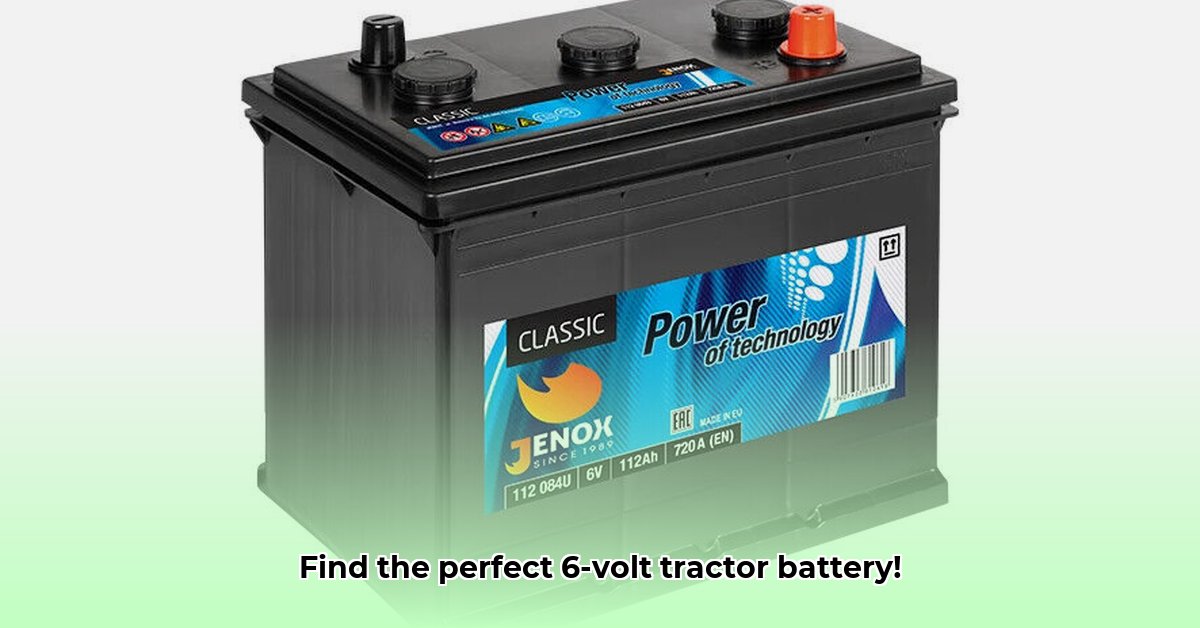
Understanding 6-Volt Tractor Batteries
Your tractor's battery is its lifeline, powering everything from the starter motor to accessories. For many older models, this means a 6-volt battery – a crucial component often overlooked until it fails. While seemingly simple, selecting and maintaining the right 6-volt battery is key to ensuring reliable operation and maximizing your tractor's lifespan. The most common type is the lead-acid battery, but within this category, several variations exist, each with its own set of advantages and drawbacks. Let's delve into the specifics. For more detailed information on tractor battery types, check out this helpful resource.
Types of 6-Volt Lead-Acid Batteries
The three primary types of 6-volt lead-acid batteries are flooded, gel cell, and AGM (Absorbent Glass Mat).
Flooded Batteries: These traditional batteries require regular maintenance, including checking and topping off the electrolyte fluid levels with distilled water. They are generally the most affordable option but demand more attention.
Gel Cell Batteries: These batteries use a gel-like electrolyte instead of liquid, eliminating the risk of spills and making them more resistant to vibrations. This translates to less maintenance. Do gel cell batteries offer a significant advantage in terms of longevity over flooded batteries?
AGM (Absorbent Glass Mat) Batteries: Similar to gel cell batteries, AGM batteries use a glass mat to absorb the electrolyte, enhancing durability and resistance to deep discharges. They tend to boast a longer lifespan. How does the cost of an AGM battery compare to a flooded battery over its lifespan?
The ideal choice depends on your specific needs and preferences. If low-maintenance is a priority, gel cell or AGM batteries are likely the better options. Flooded batteries might suffice if you're comfortable with more frequent maintenance.
Choosing the Right 6-Volt Battery
Selecting a replacement battery isn't about picking the first 6-volt unit you find. Several key factors warrant careful consideration.
Key Factors to Consider:
Cold Cranking Amps (CCA): This rating (measured in amps) indicates the battery's ability to start your tractor's engine in cold temperatures. Higher CCA values are crucial in colder climates, ensuring a reliable start even on frigid mornings. What CCA rating is recommended for my geographic region?
Reserve Capacity (RC): This rating (measured in minutes) signifies how long the battery can power accessories (lights, radio) if the engine is off. Higher RC is beneficial for tractors with power-hungry accessories. How does the reserve capacity affect my tractor's operational capabilities?
Physical Dimensions: Measure your old battery's dimensions before purchasing a replacement. The new battery must fit perfectly within the tractor's battery tray to prevent damage and ensure secure mounting. What are the exact dimensions of my tractor's battery tray?
Warranty and Manufacturer Reputation: Choose a reputable manufacturer offering a robust warranty – a sign of confidence in product quality and longevity. A longer warranty usually translates to a lower overall lifecycle cost. What are the warranty terms offered by leading battery manufacturers?
Maintenance Requirements: Consider the maintenance needs of different battery types. Flooded batteries require regular fluid checks, while gel cell and AGM batteries demand less intervention. Does the lower maintenance of gel cell or AGM batteries justify their higher initial cost?
Battery Maintenance and Lifespan Extension
Preventive maintenance is key to extending the life and performance of your 6-volt battery.
Essential Maintenance Practices:
Regular Cleaning: Clean battery terminals regularly using a wire brush to remove corrosion. Corrosion buildup hinders electrical conductivity, impacting starting performance. How often should I clean my battery terminals?
Fluid Level Checks (Flooded Batteries Only): If your battery is flooded, regularly check the electrolyte fluid level. Add only distilled water if necessary, avoiding tap water which contains impurities. Overfilling or underfilling can damage the battery. How often should I check the electrolyte level?
Proper Charging: Use a charger designed for 6-volt batteries. Overcharging can severely damage the battery. For long-term storage, consider a trickle charger which maintains a consistent charge without overcharging. How do I determine the correct charging rate for my battery?
Proper Storage: When storing your tractor for an extended period, keep the battery in a cool, dry, and well-ventilated location. A trickle charger can prevent deep discharge during storage. What are the optimal storage conditions for a 6-volt battery?
Environmental Considerations and Recycling
Lead-acid batteries contain lead, a heavy metal that requires responsible disposal. Always recycle your used battery at a designated recycling center or auto parts store to mitigate environmental impact. Are there government incentives for responsible battery recycling in my region?
Future Trends in Agricultural Batteries
While lead-acid batteries remain dominant, newer technologies, such as lithium-ion batteries, are showing promise for future agricultural applications. While offering greater energy density and longer lifespans, their higher initial cost and sensitivity to extreme temperatures currently limit their widespread adoption. Will lithium-ion batteries eventually replace lead-acid batteries in agricultural applications?
Conclusion
Choosing, maintaining, and responsibly disposing of your 6-volt tractor battery is crucial for both operational efficiency and environmental sustainability. By following the guidelines outlined in this guide, you can ensure your tractor remains a reliable workhorse for years to come.